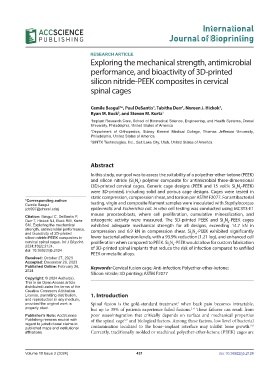Page 439 - IJB-10-2
P. 439
International
Journal of Bioprinting
RESEARCH ARTICLE
Exploring the mechanical strength, antimicrobial
performance, and bioactivity of 3D-printed
silicon nitride-PEEK composites in cervical
spinal cages
Cemile Basgul *, Paul DeSantis , Tabitha Derr , Noreen J. Hickok ,
1
1
2
1
Ryan M. Bock , and Steven M. Kurtz 1
3
1 Implant Research Core, School of Biomedical Science, Engineering, and Health Systems, Drexel
University, Philadelphia, United States of America
2 Department of Orthopedics, Sidney Kimmel Medical College, Thomas Jefferson University,
Philadelphia, United States of America
3
SINTX Technologies, Inc., Salt Lake City, Utah, United States of America
Abstract
In this study, our goal was to assess the suitability of a polyether-ether-ketone (PEEK)
and silicon nitride (Si N ) polymer composite for antimicrobial three-dimensional
4
3
(3D)-printed cervical cages. Generic cage designs (PEEK and 15 vol.% Si N -PEEK)
3
4
were 3D-printed, including solid and porous cage designs. Cages were tested in
static compression, compression shear, and torsion per ASTM F2077. For antibacterial
*Corresponding author:
Cemile Basgul testing, virgin and composite filament samples were inoculated with Staphylococcus
(cb997@drexel.edu) epidermidis and Escherichia coli. In vitro cell testing was conducted using MC3T3-E1
mouse preosteoblasts, where cell proliferation, cumulative mineralization, and
Citation: Basgul C, DeSantis P,
Derr T, Hickok NJ, Bock RM, Kurtz osteogenic activity were measured. The 3D-printed PEEK and Si N -PEEK cages
3
4
SM. Exploring the mechanical exhibited adequate mechanical strength for all designs, exceeding 14.7 kN in
strength, antimicrobial performance, compression and 6.9 kN in compression shear. Si N -PEEK exhibited significantly
and bioactivity of 3D-printed 3 4
silicon nitride-PEEK composites in lower bacterial adhesion levels, with a 93.9% reduction (1.21 log), and enhanced cell
cervical spinal cages. Int J Bioprint. proliferation when compared to PEEK. Si N -PEEK would allow for custom fabrication
4
3
2024;10(2):2124. of 3D-printed spinal implants that reduce the risk of infection compared to unfilled
doi: 10.36922/ijb.2124
PEEK or metallic alloys.
Received: October 27, 2023
Accepted: December 26, 2023
Published Online: February 26, Keywords: Cervical fusion cage; Anti-infection; Polyether-ether-ketone;
2024
Silicon nitride; 3D printing; ASTM F2077
Copyright: © 2024 Author(s).
This is an Open Access article
distributed under the terms of the
Creative Commons Attribution
License, permitting distribution, 1. Introduction
and reproduction in any medium,
1
provided the original work is Spinal fusion is the gold-standard treatment when back pain becomes intractable,
properly cited. but up to 35% of patients experience failed fusions. These failures can result from
2-4
Publisher’s Note: AccScience poor osseointegration that critically depends on surface and mechanical properties
Publishing remains neutral with of the spinal cage and biological factors. Among these factors, low level of bacterial
5-7
regard to jurisdictional claims in 8,9
published maps and institutional contamination localized to the bone–implant interface may inhibit bone growth.
affiliations. Currently, traditionally molded or machined polyether-ether-ketone (PEEK) cages are
Volume 10 Issue 2 (2024) 431 doi: 10.36922/ijb.2124

